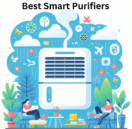Clean Air Meets Smart Home Innovation
Your home is your sanctuary, but have you ever considered what’s floating in the air you breathe every day? Dust, pollen, pet dander, VOCs from furniture and cleaning products—even carbon dioxide from poor ventilation—all contribute to indoor air pollution.
For homeowners and smart home enthusiasts, air purifiers aren’t just about filtering air anymore. They’re evolving into intelligent air management systems powered by real-time air quality sensors that track pollutants and automatically adjust filtration levels.
Imagine a purifier that syncs with your smart home, responds instantly to changes in air quality, and optimizes itself for maximum efficiency—without you having to lift a finger. That’s the power of air quality sensors in modern purifiers. Let’s explore how they work, why they matter, and how they fit seamlessly into a high-tech, energy-efficient home.
How Air Quality Sensors Work: The Tech Behind the Clean Air
Smart Sensors That Detect, Measure, and React
Unlike traditional purifiers that run on a fixed setting, smart purifiers use advanced air quality sensors to detect pollutants and adjust performance in real-time. These sensors monitor various air contaminants, including:
- Particulate Matter (PM2.5, PM10) – Detects dust, pollen, smoke, and pet dander.
- Volatile Organic Compounds (VOCs) – Identifies harmful gases from paints, furniture, and cleaning products.
- Carbon Dioxide (CO₂) – Measures ventilation levels to prevent stale, stuffy air.
- Humidity & Temperature – Helps prevent mold and optimize indoor comfort.
Using laser-based, infrared, or chemical reaction technology, these sensors analyze air composition and communicate with the purifier’s system. If pollution levels rise—say, after cooking dinner or vacuuming—the purifier automatically increases airflow and filtration power to restore air quality.
Seamless Integration with Your Smart Home
For tech enthusiasts, the real magic happens when air quality sensors connect with other smart home devices. Many Wi-Fi-enabled purifiers integrate with:
✔ Smart assistants (Alexa, Google Home, Apple HomeKit) – Control air quality with voice commands.
✔ Mobile apps – Get real-time air quality reports, adjust settings remotely, and receive maintenance alerts.
✔ IFTTT automation – Set triggers like increasing purification when pollution levels rise or adjusting fan speed when you enter a room.
Think of it as a thermostat for your air quality—always optimizing itself to create the healthiest environment possible.
Why Smart Purifiers Are a Game-Changer for Homeowners
1. Hands-Free, Hassle-Free Air Quality Management
Forget manually adjusting settings—your purifier does the work for you. When pollution levels rise, the device responds automatically, ensuring your home always has optimal air quality. Whether you’re sleeping, working, or away from home, it’s constantly monitoring and improving your environment.
Example: Hosting guests? Your purifier detects an increase in CO₂ from more people in the room and boosts ventilation to keep the air fresh and comfortable.
2. Energy Efficiency & Cost Savings
Smart air purifiers don’t just clean air; they do it efficiently. Traditional models run at full power even when air quality is good, wasting electricity and wearing out filters prematurely. Sensor-driven purifiers adjust automatically, reducing energy consumption and extending filter life.
Example: During pollen season, the purifier ramps up filtration when needed but stays in low-power mode during cleaner air periods, cutting down on energy costs.
3. Data-Driven Insights for a Smarter Home
Modern air purifiers don’t just clean—they educate. With built-in air quality tracking and historical data, you can:
✔ Identify pollution sources (e.g., noticing VOC spikes after using certain cleaning products).
✔ Monitor long-term trends in air quality and adjust habits accordingly.
✔ Get proactive filter change alerts so you never forget maintenance.
Example: If your purifier’s data shows that CO₂ levels spike every night, you might decide to improve ventilation or adjust your HVAC settings.
Choosing the Best Smart Air Purifier for Your Home
1. Prioritize High-Precision Sensors
Not all sensors are created equal. Look for models with dual-sensor technology that measure both particles and gases for a more accurate picture of air quality.
2. Opt for Smart Features & Connectivity
For full home automation, choose a purifier with:
- Wi-Fi & app support for remote control.
- Smart assistant compatibility (Alexa, Google Home, HomeKit).
- Custom automation via IFTTT to sync with other devices.
3. Ensure Industry-Standard Filtration
A great sensor is only as good as the purifier’s ability to filter pollutants. Look for:
✔ True HEPA filters (not just “HEPA-like”) for PM2.5 removal.
✔ Activated carbon filters for VOC and gas neutralization.
✔ AHAM & CARB certifications for tested performance.
Best Smart Air Purifiers on the Market
If you’re looking to upgrade your home’s air quality system, here are some top-rated smart purifiers that integrate advanced sensors with automation:
🔹 Dyson Purifier Hot+Cool HP09
✔ PM, VOC, and NO2 sensors for precise air quality tracking.
✔ Real-time air quality reports via mobile app.
✔ Heats, cools and purifies—a versatile all-season solution.
🔹 Philips Air Purifier Series 3000i
✔ AeraSense technology for ultra-accurate air monitoring.
✔ Detects PM2.5 and VOCs in real-time.
✔ Works with Alexa & Google Assistant for hands-free control.
🔹 Coway Airmega 400S
✔ Dual particle & gas sensors for enhanced detection.
✔ AI-driven auto mode optimizes energy use.
✔ Ideal for large spaces and full smart home integration.
The Future of Indoor Air is Smart
For modern homeowners and smart home enthusiasts, clean air isn’t just a luxury—it’s an integral part of a high-tech, efficient living space. With real-time air quality sensors, smart purifiers take the guesswork out of indoor air management, improving health, comfort, and convenience.
By investing in a sensor-equipped purifier, you’re not just filtering air—you’re upgrading your home’s intelligence. So, next time you think about air quality, don’t settle for a basic purifier. Go smart. Breathe better. Live smarter. 🌿💨
